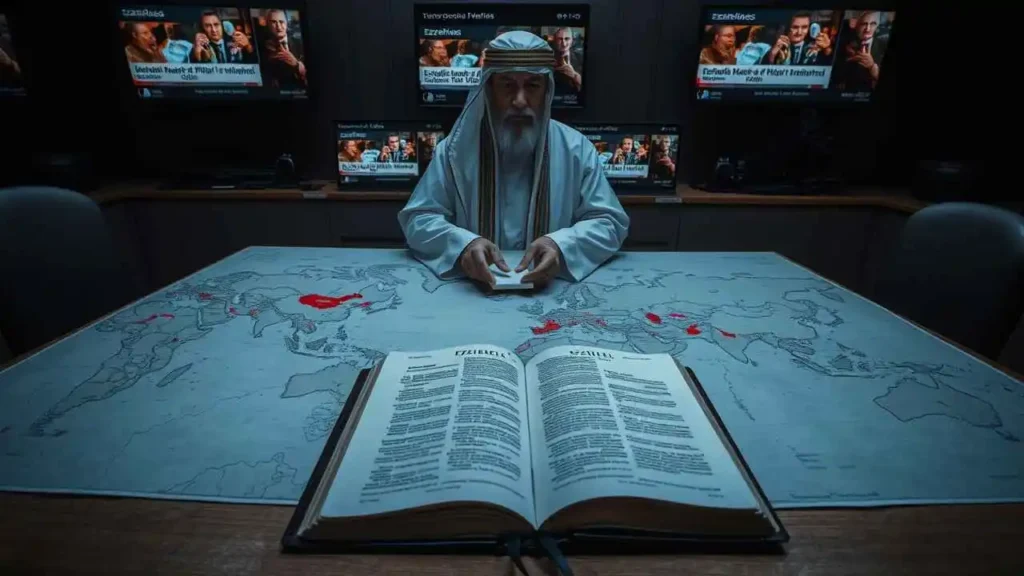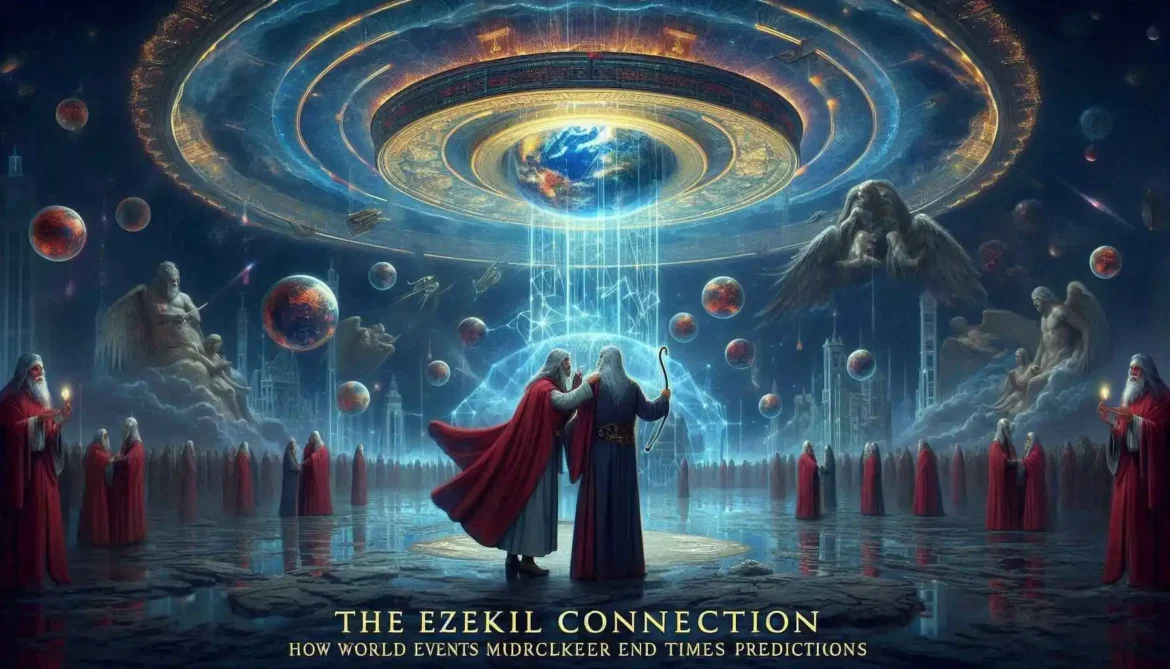
Ezekiel’s Vision and Modern Geopolitics: Are We in the Last Days?
From the dawn of civilization, humanity has grappled with the future, seeking glimpses of what lies ahead. In moments of profound global upheaval, this innate curiosity often turns towards ancient texts, particularly prophetic scriptures, to discern if current events align with long-foretold narratives. Today, as we witness an unprecedented confluence of geopolitical tensions, technological advancements, and societal shifts, many are asking: are biblical prophecies, particularly those found in the Book of Ezekiel and other sacred texts, indeed coming true before our very eyes? We embark on an exploration of these compelling connections, examining the scriptural foresights against the backdrop of the present scenario involving Iran, Israel, and other nations, and the broader concept of the Antichrist.
The Enduring Resonance of Biblical Prophecy
Biblical prophecy, for centuries, has served as both a compass and a comfort, offering believers a glimpse into the divine plan and challenging them to live lives of readiness. Unlike mere predictions, these prophecies often carry a moral imperative, urging humanity towards righteousness and revealing the character of God. Among the vast prophetic landscape of the Bible, the book of Ezekiel stands out for its vivid imagery and specific pronouncements concerning the restoration of Israel and a future conflict often referred to as the “Gog and Magog” war.
Ezekiel, writing from Babylonian captivity around the 6th century BC, delivered intricate visions detailing Israel’s spiritual unfaithfulness, its subsequent dispersion, and its ultimate regathering in the “latter days.” This regathering, a critical precursor to many end-time prophecies, is explicitly stated in Ezekiel 37:21: “Then say to them, ‘Thus says the Lord God: Surely I will take the children of Israel from among the nations, wherever they have gone, and will gather them from every side and bring them into their own land.'” For many, the establishment of the modern state of Israel in 1948, following two millennia of dispersion, represents a monumental fulfillment of this very prophecy—a signpost marking the beginning of the “end times” clock.
Beyond Ezekiel, other biblical books such as Daniel, Matthew 24, and Revelation paint a broader picture of the “end of the age” characterized by:
- Wars, rumors of wars, famines, and earthquakes: Described by Jesus as “the beginning of birth pains” (Matthew 24:6-8).
- A rise of global figures and systems: Foreshadowing a time of unprecedented political and economic control.
- Increased wickedness and a cooling of love: Indicating moral decay.
- The gospel being preached to all nations: A global evangelistic thrust.
These general trends, when observed in our contemporary world, resonate with many who study prophecy. But it is the specific nature of Ezekiel’s prophecies concerning regional powers that truly captures our attention when juxtaposed with current geopolitical alignments.
Ezekiel’s Vision: Gog and Magog in the Modern Era
Ezekiel chapters 38 and 39 describe a massive coalition of nations that will descend upon the regathered nation of Israel “in the latter years,” after it has been brought out of the nations and is dwelling “securely” (Ezekiel 38:8, 11). The leader of this confederacy is identified as “Gog, of the land of Magog, the prince of Rosh, Meshech, and Tubal.” Joining him are Persia, Cush, Put, Gomer, and Togarmah.
Interpreting these ancient names in a modern context is key to understanding their potential relevance:
- Gog of Magog, prince of Rosh, Meshech, and Tubal: While interpretations vary, many scholars identify “Rosh” with modern-day Russia, and “Meshech” and “Tubal” with regions of modern Turkey or central Asia. This places the primary aggressor in the north of Israel, consistent with Russia’s geographical position.
- Persia: This is unequivocally modern-day Iran. Its inclusion is significant and highly relevant to our current global dynamics.
- Cush and Put: Generally identified as modern-day Sudan, Ethiopia (Cush) and Libya (Put)—nations in North Africa.
- Gomer and Togarmah: Often linked to Turkey and parts of Eastern Europe or Armenia, again placing them in Anatolia and surrounding regions.
What we observe today is a striking alignment of these nations. We see Russia (Rosh/Magog) increasing its military presence and influence in the Middle East, notably in Syria, effectively positioning itself north of Israel. Crucially, Russia has forged a strategic alliance with Iran (Persia), which openly calls for the destruction of Israel. Iran, in turn, has cultivated a network of proxy forces—such as Hezbollah in Lebanon, various militias in Syria and Iraq, and the Houthis in Yemen—all aimed at encircling and undermining Israel.
The table below summarizes these striking connections:
| Prophetic Element (Biblical Source) | Common Interpretation/Context | Current Global Observation |
| Israel’s Re-gathering (Ezekiel 37) | The Jewish people returning to their ancient homeland | Establishment of the State of Israel in 1948; ongoing immigration |
| Gog & Magog Coalition (Ezekiel 38-39) | A large northern power (Russia) leading a coalition | Russia’s influence in the Middle East; alliances with Iran |
| Persia (Ezekiel 38:5) | Modern-day Iran | Iran’s stated hostility towards Israel; nuclear ambitions; proxy wars |
| Cush & Put (Ezekiel 38:5) | Sudan, Ethiopia, Libya (North African nations) | Growing instability and alliances in these regions |
| Gomer & Togarmah (Ezekiel 38:6) | Turkey, parts of Eastern Europe/Armenia | Turkey’s complex regional role; increasing assertiveness |
| “Latter Days” Hostility (Ezekiel 38) | Nations gathering against Israel in the end times | Escalating tensions between Iran, its proxies, and Israel; regional conflicts |
This alignment of historical names with modern states, particularly the explicit mention of Persia (Iran) alongside a northern power (Russia) and other specific nations, is what compels many to ponder whether these ancient words are now unfolding in real-time.
The Current Geopolitical Landscape: A Prophetic Chessboard?
The Middle East today is a hotbed of tension, a complex geopolitical chessboard where the pieces often seem to move in concert with ancient prophecies.
- Iran’s nuclear ambitions and its stated goal of eradicating Israel are not mere political rhetoric; for many prophecy watchers, they are direct echoes of Ezekiel’s pronouncements. Iran’s development of long-range missiles and its funding of terrorist groups aimed at Israel represent a tangible threat.
- Israel’s precarious position amidst hostile neighbors, its robust military, and its continuous struggle for security, further resonate with the biblical narrative of a nation surrounded yet ultimately protected by divine intervention.
- Russia’s increasing assertiveness on the global stage, particularly its deep involvement in Syria, placing its military assets uncomfortably close to Israel’s northern border, aligns with the interpretation of Russia as the lead nation of the Gog-Magog coalition.
- We also observe a growing coalition of nations with shared interests, some aligning with Russia and China (forming an “eastern” bloc), others with Western powers. This shifting global dynamic creates an environment ripe for the formation of the very alliances described in Ezekiel.
Beyond these specific regional dynamics, deeper global trends also stir prophetic contemplation:
- The constant drumbeat of wars and rumors of wars: From the ongoing conflict in Ukraine to simmering tensions in the South China Sea, the world seems perpetually on the brink of wider conflict.
- Economic instability and talk of global financial resets: The volatility of global markets, the rise of digital currencies, and discussions about a new world economic order resonate with prophecies of a coming global economic system.
- The unprecedented rise of natural disasters: Earthquakes, floods, and extreme weather events seem to intensify in frequency and severity, prompting many to recall biblical warnings of escalating “birth pains.”
The Concept of the Antichrist and a One-World System
Beyond the regional conflicts, the Bible also speaks of a future global political and spiritual leader, often referred to as the Antichrist, who will rise to prominence during a time of great tribulation (Daniel 7; 2 Thessalonians 2; Revelation 13). This figure is depicted as:
- A charismatic and powerful leader who brings a temporary peace.
- A deceiver who will demand worship and control global commerce.
- A persecutor of those who resist him.
While we are not suggesting any specific individual is the Antichrist, we can observe the societal and technological scaffolding that could facilitate such a reign. The rapid advancements in:
- Global surveillance capabilities: Enabled by AI, facial recognition, and interconnected digital systems.
- Digital identification and currency systems: Potentially leading to unprecedented control over an individual’s buying and selling.
- The erosion of national sovereignty and the push for global governance: Seen in international bodies and treaties, fostering an environment where a single powerful entity could potentially exert vast influence.
- The rise of powerful, persuasive figures: Leaders who command significant media attention and possess the ability to sway large populations.
These trends, when viewed through a prophetic lens, suggest an increasing preparedness for a system that could easily be manipulated by a figure seeking ultimate control.
“The prophetic word is not merely a forecast of future events, but a divine lamp unto our feet, illuminating the path ahead so that we might walk in wisdom and readiness.” — Charles Spurgeon (paraphrased)
Our Call to Watchfulness and Reflection
For those who lean into the study of biblical prophecy, the current global scenario presents a compelling case for its unfolding. We are witnessing:
- The re-establishment of Israel, a foundational prerequisite for many end-time prophecies.
- The formation of alliances among nations explicitly named in ancient texts, positioning themselves against Israel.
- A global climate rife with instability, economic shifts, and technological advancements that could usher in a new world order.
These are not isolated incidents but patterns that, when connected, paint a striking picture. While we must exercise caution against setting dates or making definitive pronouncements—for “of that day and hour no one knows” (Matthew 24:36)—it is incumbent upon us to be watchful, discerning the signs of the times.
Ultimately, whether one interprets these events as a direct fulfillment of biblical prophecy, the cyclical nature of human history, or mere coincidence, the current global climate merits serious consideration. The ancient words echo with a newfound urgency, prompting us to reflect on our place in this unfolding narrative and to consider the spiritual implications for our lives and for the world around us. We are, undeniably, living in times that are both challenging and profoundly intriguing, forcing us to ask: are we witnessing the dawn of a new era, or the culmination of one long foretold?
Ezekiel, Present Geopolitics, and the Antichrist





